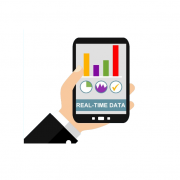5 reasons why you need real time banking
Going real time means benefits as well as challenges. See how banks can navigate the transition using a gradual approach and tools like Payres.
When it comes to the banking client, the leniency margin is decreasing. Customers treat their bank like an online store. Things must be happening instantly and real time payments are a must. What exactly do they require from their bank accounts? “Let me handle it myself, when and where I want.”
In the case of the traditional model, transactions are queued and settled in batches. Only internal transfers in a given bank are processed immediately. In the case of interbank settlements, the customer must reckon with a delay of at least a few hours, not to mention other problems, e.g. fraud detection and counteraction.
As e-commerce services accelerate towards real-time payments, banks need to find a way to keep pace with it and go far beyond traditional payment methods. Real-time data processing can help solve current problems. More than that, it might become the foundation for new services.
As banking expert, advisor and futurist Brett King points out, “the best service in financial services happens in real-time and is based on customer behaviour”. Switching to real-time operations is not easy in banking. Many institutions face enormous efforts on their way to the top. Why then is this journey worthwhile?
Benefits of real-time for banks
Sooner than later, banking systems must come to terms with the growing popularity of an increasingly open, mobile and real-time financial ecosystem. As banks improve efficiency, add instant payments and open up to the customer, a real-time and data-driven approach is needed. The effort pays off bringing benefits like:
a. Improving access to data
Customers trust banks and financial institutions, which give them instant access to their money. Real/time access to funds becomes not a luxury, but a given. The possibility to view and access data in real-time also means that every participant in the process: a customer using a mobile application, a consultant or a customer service department sees the same, up-to-date information and can make well-informed decisions.
b. Warm-hearted approach to the client
As they say, emotions are good when fresh. The same goes for digital banking. Reaching the customer in real-time, when they face difficulties, have problems signing up to a new application, or can’t pay for a service due to an overdue spending limit, is the key to a successful customer service. Genuine empathy is reflected in an instant!
c. Increasing innovation
Customers expect banking services – not only digital payments – to be delivered on time and in the right context. Moreover, real-time payment systems provide immediate, high-precision data that analysts can use to efficiently cross-sell services based on specific transactions and the customer’s financial behaviour. Forward-thinking banks harness the power of real-time to both innovate and exceed customer expectations. And if the banks fail to do so, other players and financial institutions in the financial market will take over.
d. Increasing efficiency
By adopting real-time technology, banks can cut their costs. How? Real-time transaction settling means that next- or other-day processing is significantly reduced, or even eliminated, including exceptions. Many manual processes can be automated and streamlined. Newer technology frees banks from managing and synchronizing multiple databases while enhancing many aspects of data recovery and business continuity. Real time payments network is just a piece of the puzzle.
e. Fraud prevention
Real-time processing dramatically improves fraud detection and prevention. When transactions are processed in real/time, an attempted fraud can be picked up immediately, contrary to overnight processing, which can cause an irreversible delay. This way the bank has the tools to detect any suspicious behaviour as it occurs. Therefore, customers feel protected and banks spend less time and resources fighting fraud while still supporting faster payments.
Banking architecture follows people, not products
Most of the banks or financial institutions operating on the market have evolved in line with the direction of product and channel development, and the bank’s IT structure has followed their course. However, the bank of the future will not be product-, but customer-oriented. Artificial intelligence, machine learning, event transmission and advanced analytics will use real-time data to deliver tailored services and consulting when the customer needs it.
Implementing real-time processing can be quite a challenge, as it affects almost every business process. We are talking about an entire real-time ecosystem. The good news is that you don’t have to do it all at once and that you can use proven solutions. Secure token exchange plays a crucial role in enhancing security and reducing fraud in real-time payments.
Change can be gradual, starting with central processes and developed as benefits appear. With gradual migration, risk can be reduced and investments aligned with business success. It is a race that can be run in stages.
Immediate payments: not a flat run, but an orienteering
Transitioning to real-time is more like orienteering than following a strictly defined track. The standards developed by retail cannot be directly applied in banking, so there is no ready-made script. There are no “better” processes, worth transforming in the first place, and “worse”. We are moving along terra incognita, so when taking steps forward, we must consider the possible need to withdraw from the previously introduced mechanism.
By implementing real-time, we go far beyond the framework of financial calculations and optimization, moving towards the psychology of social sciences, supported by power computing. Real-time brings huge potential, but will also require adopting a new dimension of testing. It’s similar to the COVID-19 vaccine: it was completed long before it was cleared for use because clinical trials were needed. However, the fact that the test subject produced antibodies following the vaccine shot is only the first step.
This is similar to software testing, as discussed on our blog, in an article on Agile software testing in banking. Whether it is about immunity, or real-time processing, the next step is to find a representative group on which to test the process over time, to spot the most serious shortcomings. Only at the last stage of the process will we observe the effects of social changes that will take place in the following weeks or months.
Therefore, it is crucial to use the tools with agility when reacting to changes in decisions embedded in their DNA. It is not only about the agility to make changes quickly, but also to quickly withdraw from a wrong decision. I believe that the possibility of shaping these tools, their functionality, and adapting to newly discovered or tested process properties is critical. This is what Payres does, our solution for introducing real-time interactions triggered by existing data flows.
Want to discuss real-time banking solutions? Contact us!

